‘Behemoth’ is a word which springs to mind or, perhaps more nautically, ‘leviathan’.
- Crafted quality structure with bulletproof engineering
- Excellent performance under sail and power
- Designed and built with an emphasis on seaworthiness
When boatbuilder Bob Huntington decided to build a catamaran for himself and wife Judy to voyage offshore, there was only one designer on his short list – Ron Given.
This latest collaboration between designer and boatbuilder has produced an absolute gem of an offshore catamaran, the 14.5m Katoa.
The Katoa project began 15 years ago in a 18m x 10m shed on the couple’s Dairy Flat property. Most catamarans are built as separate components – two hulls and a bridgedeck – which are later joined together. However, Huntington opted to build Katoa as one integrated structure, a far stronger method.
Construction
The foam-sandwich hulls were built upside down on top of the ply/foam/ply sandwich bridgedeck. Once the structure had been faired externally, it was pulled out of the shed, craned over, then put back inside upright for the internal glassing. Most of the decks and cabin were built as flat foam/glass panels on a table, then assembled onto the hull and bridgedeck with generous coves to soften the angles.
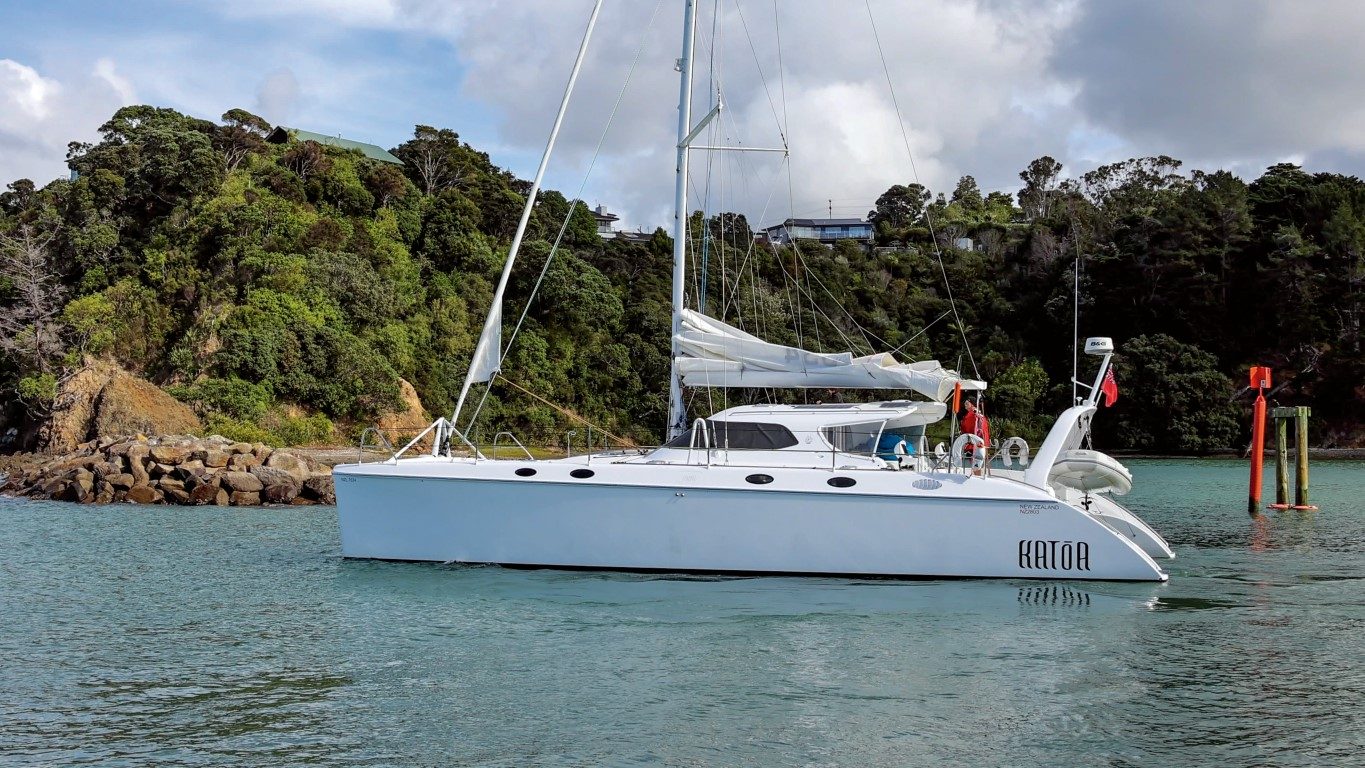
Read quickly, this all sounds easy, but the reality was very different. It took Huntington 10 years part-time and three years full-time work to get from drawings to launching. Even at a cursory glance from the dockside the vessel is impressive enough, however the real depth of Huntington’s perfectionist approach is only apparent upon close examination. Multihull designer and boatbuilder Tim Clissold, who carried out Katoa’s Category One Inspection, was equally impressed with Huntington’s workmanship and attention to detail.
The modest Huntington is quick to acknowledge Judy’s support, without which this project wouldn’t have happened.
Layout
Katoa follows Given’s well proven layout, which works equally well at sea and at anchor. The hub of the boat externally is the T-shaped cockpit, where inboard seating provides excellent shelter from sun, wind, rain or driving spray. A permanent roof covers the seats, while the gap between there and the radar arch is filled with a removable Sunbrella cover when required. While the outboard helming stations are exposed, the integrated autopilot system means that hand-steering is only required when necessary or desired.
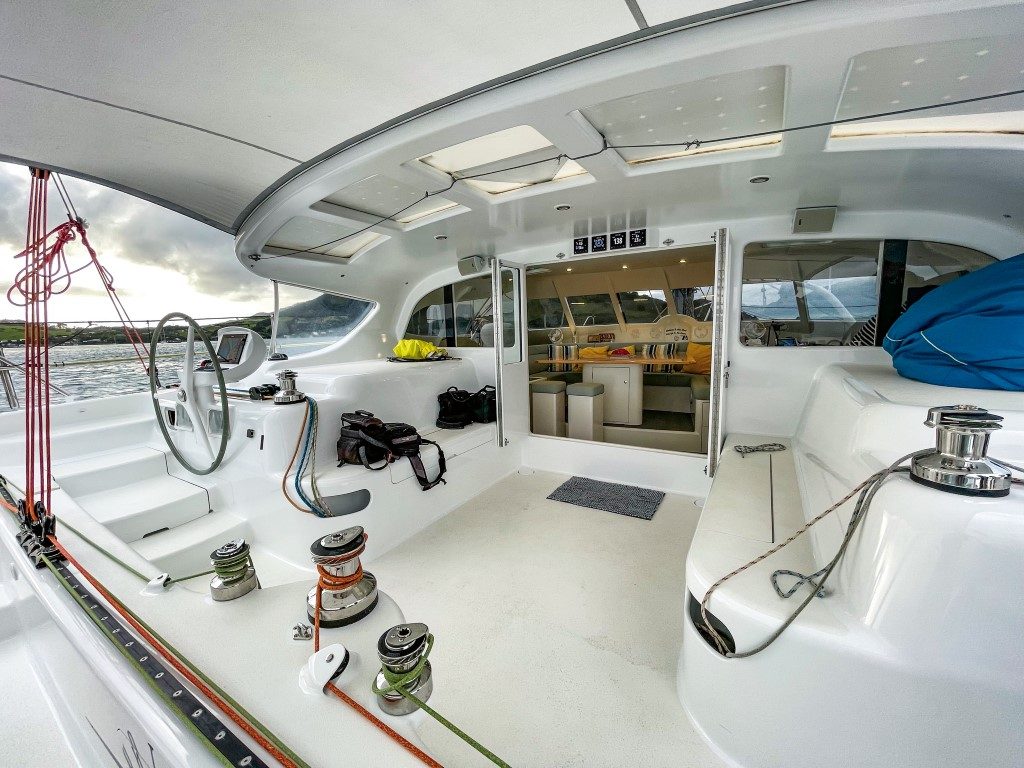
Each steering station has a custom pod housing the engine and auto-pilot controls, plus a chart-plotter. Autopilot controls and chart-plotter are duplicated at the chart table, so the boat can be controlled, and its position monitored, at any of these three locations. Additionally, there are four B&G multifunction displays above the entrance to bridgedeck which can be seen from either helm.
The internal hub of the yacht is the U-shaped saloon table on the bridgedeck. The floor is raised around it so those seated enjoy virtually 360-degree views through the expansive windows. It’s a fabulously sheltered spot, both at sea and at anchor.

The navigation station to starboard of the saloon table houses computer, radio, instrument repeater displays and autopilot controls, with the main switchboard off to one side. Aft and diagonally opposite is an angled bench housing the TV, with space for laptops, phone charging and the like – sort of a family electronics space.
The port hull contains the midships galley, which has been designed for cooking offshore. The main bench, sink, stove top and eye-level oven are all on the inboard side, with another smaller bench, fridge and freezer outboard. The centreboard case is set against the outboard side of the hull and isn’t intrusive.
Forward of the galley is an athwartships double bunk, heads and shower, whilst aft is the double guest cabin.
The aft starboard hull has the owners’ walk-through ensuite heads/shower and cabin. The queen-sized berth itself, like its twin opposite, is located inboard over the bridgedeck. The starboard forward hull contains a laundry, bench and, right forward, a single berth, beneath which is Huntington’s tool locker.
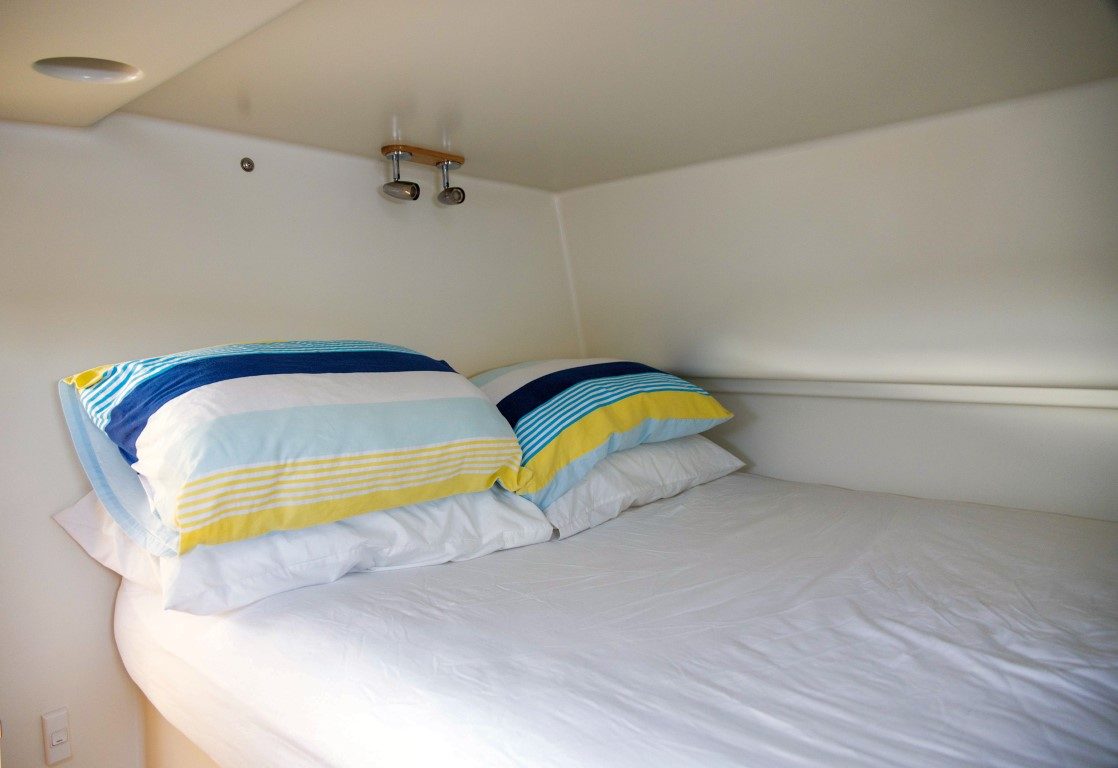
There are two watertight bulkheads in the forward section of each hull, the first carries the forebeam loads whilst the second creates massive deck lockers for fenders, spare sails and the like.
Aft of the sleeping cabins are two more watertight compartments in each hull, one forming the engine rooms, the other for the rudders. The rudders themselves are foam and glass over 50mm stainless steel shafts and, with the centreboards up, are the lowest part of the boat, although not by much. Draft varies from 1.1m to 2.0m. With temporary props to protect the sail-drives, Katoa can be easily beached for maintenance.
Most catamarans this size are fitted with hydraulic steering but instead Huntington crafted a custom Dyneema rope and quadrant system to provide more feel. The autopilot is an electrical planetary drive directly mounted on the starboard rudder quadrant.

Katoa’s engine rooms are accessed through deck hatches just aft of the helms. The engines are Nanni four-cylinder, naturally aspirated conversions of a Kubota block and develop 47hp apiece at 2,800rpm. These drive Ewol feathering propellers through SD10 sail-drive units. While Katoa can motor at 10 knots, comfortable cruising is around 7.5 to eight knots. Given believes cruising cats should have sufficient tankage to motor at least 1,000nm and Katoa carries 1,200 litres of fuel in four tanks. There are twin 35-litre hot water tanks heated from the engine heat exchangers.
As befits an offshore voyager, the anchor system is impeccably engineered. An Excel anchor sits in a housing on the composite forebeam, with its windlass and chain located in a large locker immediately forward of the mast. This keeps weight out of the bows, while the locker also provides waterproof, all-weather ventilation, essential in heavy weather offshore.
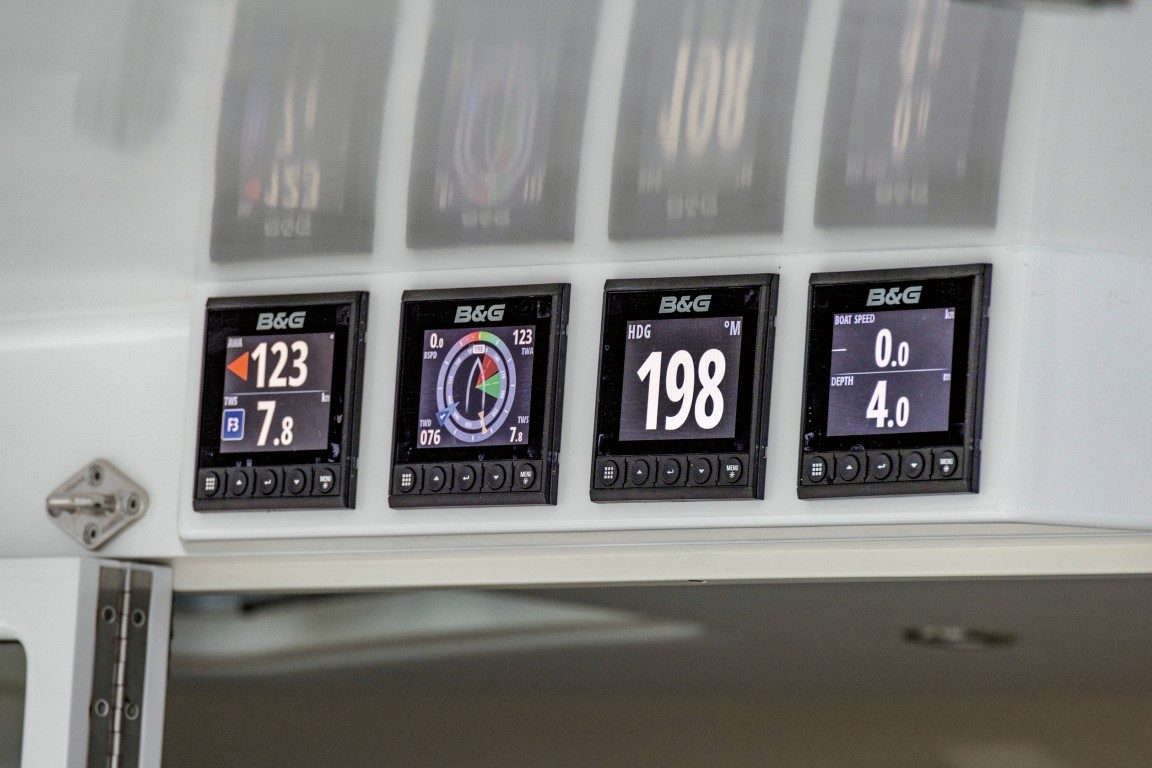
The rig is typically Given and has been refined over countless offshore miles. One small refinement Huntington incorporated was having separate upper and lower shroud terminations, allowing a comfortable walkway between them when going forward. The shrouds terminate onto large stainless pins, in turn secured with moulded Carbon housings – chainplates for want of a better word – that effectively become a permanent part of the hulls. Nothing to corrode or leak here, a major benefit in later years.
The sails were built by Dertek from Spectra cloth. The mainsail is square topped, fully battened and employs points reefing for simplicity. For easy handling, Huntington crafted a stylish Park Avenue boom to hold the mainsail when dropped. The headsail is attached to a Harken furler and is self-tacking, another boon when short-handed. The other sails carried are a gennaker, and both heavy weather and storm jibs.
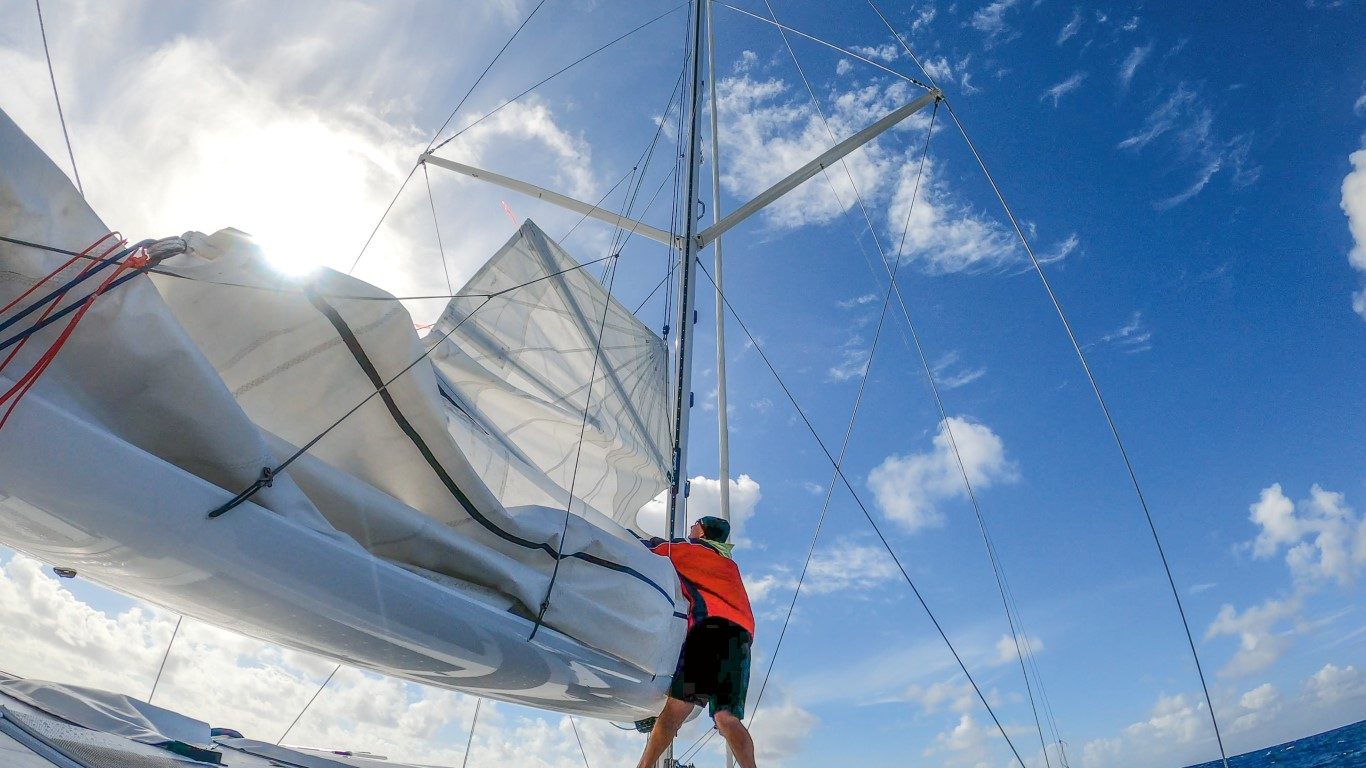
The winches are mostly two-speed manual Andersons, apart from the port primary which is electrically powered. Besides the twin primaries, which control most of the sailing and centreboard functions, there’s another on the mast, plus a cluster of three winches in the middle of the main traveller to control the mainsail. Incidentially, one end of the mainsheet terminates at an emergency release – pull a toggle and the mainsheet is dumped.
“Bit of mission re-reeving it,” Huntington comments dryly.
On the water
Our original test day in Auckland had to be cancelled due to a passing cyclone and with the Huntingtons committed to join a cruising rally to Fiji, we had a tight timeframe for our test. Thankfully we were able to join the Huntingtons for a quick trip up the coast from Marsden Cove to Tutukaka, some 24 nautical miles in all.
Hughie didn’t send us the nicest day; an overcast sky, a lumpy, leftover NE swell, a breeze that couldn’t decide between 10 and 25 knots and the odd rain squall. Wisely, Huntington opted for a tuck in the big roached, square-topped main, which is hoisted by the powered port primary winch.
“You need to watch this, it can do a bit of damage quickly if you don’t,” he informs me. I mentally resolve to keep fingers and toes well clear. With the main halyard jammed off, this winch is freed for its other tasks – in this case port centreboard up and down, and jib sheet and traveller.

With the self-tacking jib unfurled, Katoa attacks the confused seas with gusto, pointing considerably higher and faster than a pair of monohulls obviously doing the same passage. Whilst Katoa felt under-canvased at times, periodic gusts coming through confirmed Huntington’s reefing call was a wise one.
I’m on the helm when one nasty 25-knot rain squall came through and the 10.5-ton Katoa started feeling decidedly frisky. Huntington quickly furled the headsail until the squall disappeared, an easier, quicker option than putting a second reef in the main.
Despite the lumpy, confused seas and changeable breeze, Katoa felt great throughout. She’s the sort of boat that covers the ground effortlessly and deceptively quickly. Huntington’s Dyneema steering system worked brilliantly and helming was delightful.
It was with regret we reached Tutukaka and, after dropping the sails, headed in under power. Huntington gave us a graphic illustration of Katoa’s manoeuvrability under power. Once past the breakwater, he spun Katoa around on the spot, then backed her millimetre-perfect up to the wharf. One rope to hold the stern while we stepped ashore, then Huntingtons were gone. Very slick.

The weather conditions prevented our photographer from flying his drone, so we drove to a nearby hill to photograph Katoa under sail. The Huntingtons had wasted little time in continuing their passage to the Bay of Islands; now with two reefs in the main, Katoa was rapidly disappearing up the coast into a building breeze.
Since then, they’ve successfully voyaged to Fiji and are currently kicking back enjoying life in the tropics. And after 13 years hard slog building her, who can begrudge them that?
Well done Bob and Judy Huntington.
‘Behemoth’ is a word which springs to mind or, perhaps more nautically, ‘leviathan’.
White Pointer has earned the respect of discerning customers in New Zealand and Australia, attracting a loyal and ever growing following for its high-quality, rugged and totally dependable aluminium trailer boats.
The hardtop SP635 shares the same underpinnings as the popular SF 635 which was a completely new model back in 2020.
The pride and joy of a multi-generational family, Bliss resides on a pier that’s home to a couple of other Elite motor launches – Sandspit Marina is a hot-spot for the Bill Upfold-designed vessels, with several calling this small marina home.